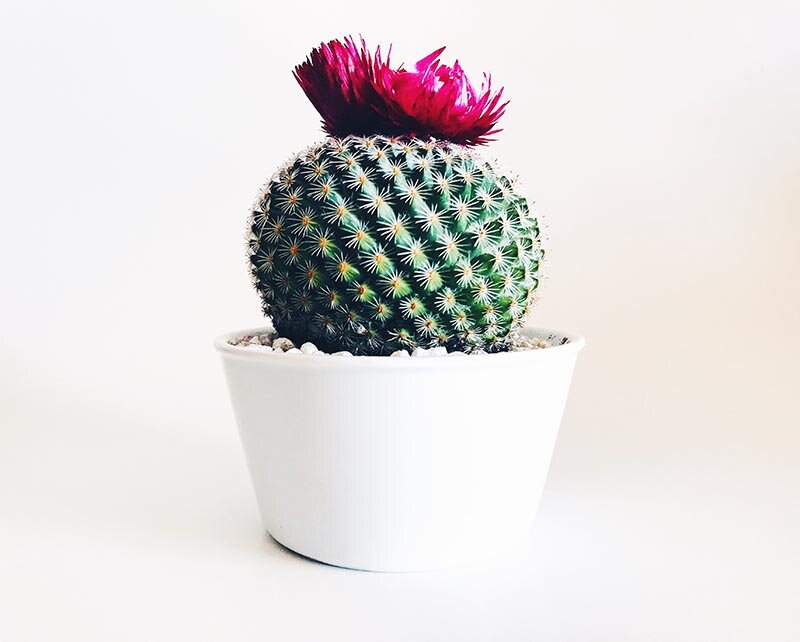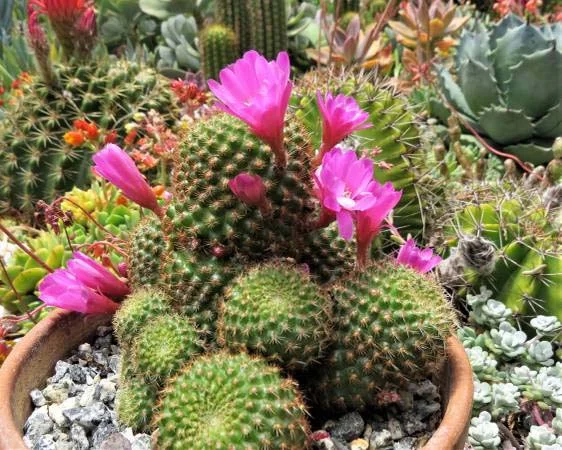The Mystery of The Fake Cactus Flowers
Big-box stores are fooling us into buying visually enhanced plants. Why do we fall for it?
By Toni Callwood
Does this cactus look real to you? Because it’s not entirely.
It’s possible you’ve been punked by a cactus and you don’t even know it.
From Home Depot to Walmart to Trader Joe’s, the spiky desert plants are now sold seemingly everywhere, offering shoppers the chance to add some low-maintenance greenery into their homes. There are more varieties available than ever before, and cactuses are being grown in a dazzling array of colors, sizes, and shapes.
Want one that’s miniature and hot pink in hue? You can find that.
What about a Dr. Seussian one that looks like a gloved hand with a million fingers? You can find that, too.
But here’s the thing, some of the cactuses you’re buying might be phonies. Especially if you’ve seen one with flowers, it’s most likely fake.
Thanks to clever placement and a hot glue gun, those colorful blossoms are but cosmetic alterations, often placed on the very tops of cactuses, particularly on the small ones.
They’re easy to fall for. Made out of dried strawflowers (a real flower native to Australia), they’re especially deceptive because, even when dead, they still open and close depending on the humidity.
Fake flowers spotted on cactuses being sold at a Home Depot in northern California. (Photo: Jessie Schiewe)
And it’s not like flowers on cactuses are totally foreign.
Theoretically, all cactus species are capable of producing flowers, but certain conditions, like the plant’s age and environment, can prevent this from occurring. It can often take years for the flowers to grow, and when they do, they usually only last for a few days.
Unlike the glued-on fakes, real flowers also grow on stems, not straight out of the plant. And if your cactus has blue flowers, that’s another indicator that they’re not real.
Still, the dyed strawflowers fool a lot of people. And not just customers and novice gardeners, but store employees, too.
At a CVS in Oakland, Calif., where you can often find trays of small cactuses adulterated with faux flowers for sale, a store employee named Maria was positive they weren’t fake.
“Yeah, they’re real,” she told OK Whatever. “Definitely. Real.”
Those who know about the fake flowers tend to abhor them. Lisa, a Home Depot employee in Long Beach, did not seem particularly happy that her store sold them. “As a nursery person, I think it is ridiculous,” she said.
The topic has been discussed in-length in online communities and blogs. In a post on the home design website Houzz, a user named Jessica called the faux flowers “stupid” and said she wasn’t the only one who felt that way.
“This year, I've been actively involved in an online forum for cacti and succulent lovers from around the world,” she wrote. “We all agree, the fake flowers look ridiculous.”
Even CVS Pharmacy peddles the visually-enhanced plants. (Photo: Jessie Schiewe)
They can also be quite damaging. Because they’re often glued on top of the cactus, the fake flowers stunt the plant’s growth by blocking key spots for sunlight absorption. The cactus can also be harmed when slicing off the fake flowers. Chunks of both the plant and its spine are easy to accidentally chop off during the removal process, and though it probably won’t kill the plant, it does leave a scar.
Once you realize they’re phonies, it’s difficult to have affection for the appliqued blossoms, no matter how vibrant their hues may be.
Sharmain Sobhani, a novice gardener in Oakland who recently purchased “flowering” cactuses from CVS, gave her new purchases away to a neighbor once she learned she’d been “bamboozled.”
“I love breathing, thriving plants and watching them grow,” she said. “I don’t want plastic glued to my plant.”
So who’s to blame for this deluge of faux cactuses? Not the stores selling them. According to Maureen, a Home Depot employee who answered a similar query from a customer in an online discussion page from 2014, the cactuses arrive at the stores with the flowers already glued on.
“They actually come that way from the grower!” she wrote.
On her post in Houzz, Jessica shared a similar revelation after emailing a cactus supplier and discovering it was them who tacked the blossoms on.
“Our big-box store customers require us to do it,” the supplier told her.
Real flowers on cactuses (like these) have stems, don’t grow straight from the top of the plant, and are usually pink in hue. (Photo: Jessie Schiewe)
Why? Because they sell better. For whatever reason, customers are more prone to purchasing cactuses with flowers than they are their au-natural counterparts.
The supplier that Jessica emailed found that the ones with faux flowers sold three times more than the ones without. Maureen from Home Depot had also observed the flowered cactuses’ winning charms on shoppers. She wrote:
“The bright, beautiful colors of the strawflowers attract customers from across the store.”
So what does this tell us about the cactus-selling industry?
For one thing, most of its customers are new to gardening.
The supplier Jessica emailed described their buyers as “not plant people” who “don’t know a potato from a petunia.” These kinds of customers don’t care if what they’re buying is real or man-made, they “just want something cutesie and decorative.”
Maureen had another take on the flowers. Maybe, she thought, they aren’t so much dupes as they are consolations for the fact that your cactus will probably never flower.
“It is a rarity to buy cactus plants in flower, which is why I believe the strawflowers are added — to add color while you wait for the real thing.”












Big-box stores are fooling us into buying visually enhanced plants. Why do we fall for it?